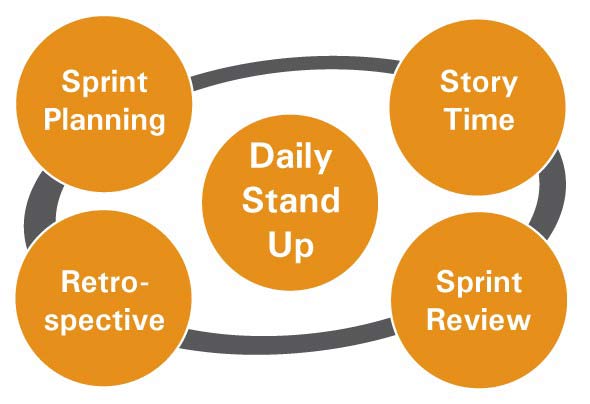What is Scrum?
Scrum is one of the most popular agile frameworks for software development and product management. It encourages team collaboration and continuous improvement. The Scrum team work together in short bursts of activity called “Sprints”, typically a one or two week period.
The roles within Scrum are as follows:
The Product Owner - The person responsible for leading the team and ensuring the output meets customer’s expectations and priorities. The product owner oversees the creation of user stories and prioritising them before work begins.
Scrum Master - The person responsible for promoting and supporting the process and ensuring any blockers preventing the team’s progress are removed.
The Team - The people who get the work done, designers, front and back end developers and QA engineers.
The weekly routine
Stand-up Meetings
Every morning at 9.30am around the “big TV”, the team report back on the following:
- What I did yesterday
- What I’ll do today
- Any blockers (anything stopping me working).
Story time
A planning session for the team to take any new client requirements and estimate how long a piece of work is going to take. This helps us improve accuracy of quotes and project plans, so work is delivered on time. We use a deck of cards with a variety of numbers representing time, so each member of the team gets a say on the estimation. The whole team has to agree on the estimate.
Sprint review
Anyone within the business is welcome to attend this meeting and see what has been done during the Sprint and what has been improved. Typically this involves a demonstration which clients are also welcome to attend where applicable.
Sprint retrospective
Following the Sprint Review we look at what went well, what didn’t go well and what might make things go better next time. This usually means we have one or two things to continue, stop and start doing in the next Sprint. This continuously improves our own process.
Sprint planning
This meeting kicks the Sprint off (usually first thing on a Wednesday morning). First, we calculate our resource for the Sprint, then the team commit to what user stories (or tasks) will get done. A goal is then agreed with the team before the Sprint can begin.

What about urgent requests?
Alongside the Scrum Team we have a Support Team containing at least one front and one back-end developer at all times to deal with urgent issues that require immediate attention.
How were you working before?
Prior to scrum each developer had their own clients and projects. This could cause delays if a developer was unavalible or moved on from Webnetism. It also meant that we weren’t working together as a team and sharing knowledge as best we could.
What is the benefits to our clients?
Our clients will benefit as we can plan delivery far more accurately than we could before. With a team of developers working on a project, rather than a single person, we can develop faster and more accurately with less risk to your business and ours.
Can you provide more information on Scrum?
Scrum was established as a process in the early 1990s so there are plenty of resources available. If you want to read more just search for "scrum" or visit www.scrum.org.